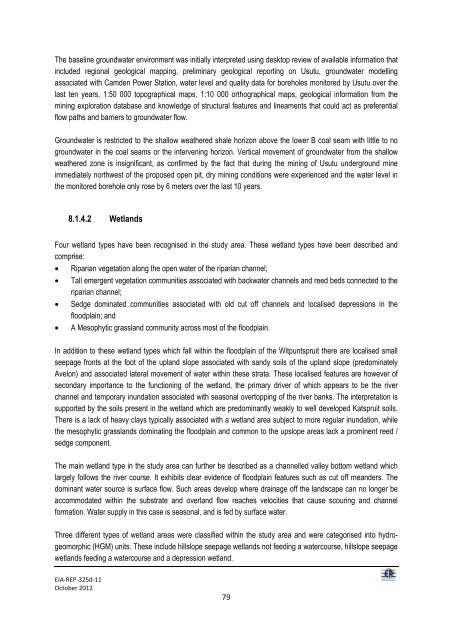EIA-REP-325d-12 _BB_ - 201.09.14.pdf - SAHRA
EIA-REP-325d-12 _BB_ - 201.09.14.pdf - SAHRA
EIA-REP-325d-12 _BB_ - 201.09.14.pdf - SAHRA
You also want an ePaper? Increase the reach of your titles
YUMPU automatically turns print PDFs into web optimized ePapers that Google loves.
The baseline groundwater environment was initially interpreted using desktop review of available information that<br />
included regional geological mapping, preliminary geological reporting on Usutu, groundwater modelling<br />
associated with Camden Power Station, water level and quality data for boreholes monitored by Usutu over the<br />
last ten years, 1:50 000 topographical maps, 1:10 000 orthographical maps, geological information from the<br />
mining exploration database and knowledge of structural features and lineaments that could act as preferential<br />
flow paths and barriers to groundwater flow.<br />
Groundwater is restricted to the shallow weathered shale horizon above the lower B coal seam with little to no<br />
groundwater in the coal seams or the intervening horizon. Vertical movement of groundwater from the shallow<br />
weathered zone is insignificant, as confirmed by the fact that during the mining of Usutu underground mine<br />
immediately northwest of the proposed open pit, dry mining conditions were experienced and the water level in<br />
the monitored borehole only rose by 6 meters over the last 10 years.<br />
8.1.4.2 Wetlands<br />
Four wetland types have been recognised in the study area. These wetland types have been described and<br />
comprise:<br />
• Riparian vegetation along the open water of the riparian channel;<br />
• Tall emergent vegetation communities associated with backwater channels and reed beds connected to the<br />
riparian channel;<br />
• Sedge dominated communities associated with old cut off channels and localised depressions in the<br />
floodplain; and<br />
• A Mesophytic grassland community across most of the floodplain.<br />
In addition to these wetland types which fall within the floodplain of the Witpuntspruit there are localised small<br />
seepage fronts at the foot of the upland slope associated with sandy soils of the upland slope (predominately<br />
Avelon) and associated lateral movement of water within these strata. These localised features are however of<br />
secondary importance to the functioning of the wetland, the primary driver of which appears to be the river<br />
channel and temporary inundation associated with seasonal overtopping of the river banks. The interpretation is<br />
supported by the soils present in the wetland which are predominantly weakly to well developed Katspruit soils.<br />
There is a lack of heavy clays typically associated with a wetland area subject to more regular inundation, while<br />
the mesophytic grasslands dominating the floodplain and common to the upslope areas lack a prominent reed /<br />
sedge component.<br />
The main wetland type in the study area can further be described as a channelled valley bottom wetland which<br />
largely follows the river course. It exhibits clear evidence of floodplain features such as cut off meanders. The<br />
dominant water source is surface flow. Such areas develop where drainage off the landscape can no longer be<br />
accommodated within the substrate and overland flow reaches velocities that cause scouring and channel<br />
formation. Water supply in this case is seasonal, and is fed by surface water.<br />
Three different types of wetland areas were classified within the study area and were categorised into hydrogeomorphic<br />
(HGM) units. These include hillslope seepage wetlands not feeding a watercourse, hillslope seepage<br />
wetlands feeding a watercourse and a depression wetland.<br />
<strong>EIA</strong>-<strong>REP</strong>-<strong>325d</strong>-11<br />
October 20<strong>12</strong><br />
79

















